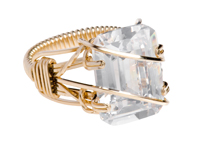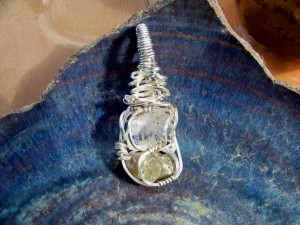- NEW DVD Series – Stone Setting with Bezels
- Tube Set Charm by Kim St. Jean
- Prong Basket Pendant by Kim St. Jean
- NEW DVD Series – Stone Setting with Cold Connections
- New DVD Series – Stone Setting with Wire
- NEW DVD Series: Introduction to Stone Setting by Kim St. Jean
- Featured Tool: Bracelet Bending Plier
- NEW Dvd by Eva Sherman
- Fun, Fast Fold Forming DVD Series
- Double Band Ear Cuff from Alex Simkin
Gem Profile Apr. 12: Diamond
by Layna Palmer, Wire-Sculpture.com

Diamond
Shop Diamond CZ Stones | Shop Quartz Gems | Shop White Topaz Gems
“Diamonds are Forever” is a phrase you have heard from DeBeers to James Bond, and it fits, because diamonds are the most popular gemstone in the world, the top of the Moh’s hardness scale, and the standard by which so many things are measured.
We have learned how gems and diamonds are graded from previous blogs, and that they are created from pure carbon in science classes, so we’re going to explore how diamonds are formed and their place throughout history instead.

A round, diamond-like clear white cubic zirconia stone – a fraction of the price of a real diamond, and no one would be the wiser!
How a Diamond Forms
Through scientific experiments, we know that diamonds are created under extreme heat and pressure near the mantle, at between 87 and 120 miles below the Earth’s surface. Without this heat and pressure, the atoms that bond to form diamonds would instead form graphite. So, if diamonds are created at such depth with so much heat and pressure, how do they get to the surface where smitten couples use them as a symbol for undying love? Good question!
Commercially-mined diamonds were first found near Kimberley, South Africa in the 1870s, in what is now known as kimberlite pipes. These pipes are formed by small but violent volcanic eruptions that originate in the upper mantle and form carrot-shaped columns, or pipes, that include diamonds, mantle material, and other rock and indicator minerals that form the breccias within the pipes (breccia is broken material). The shape of the pipe is an inverted cone caused by the surface water exploding as the hot magma comes in contact and literally blowing it out of the Earth!

Dale “Cougar” Armstrong teaches many rings in her Rings DVD Series, including this beautiful CZ stone held in a prong ring.
Kimberlite doesn’t create diamonds; it merely acts as the elevator getting it from the mantle to the surface of the Earth. There is not a specific hardness for kimberlite because it contains so many different types of material like mantle fragments (xenoliths), limonite, olivine, zircon, garnet, chromites, and of course diamonds all suspended in the crystallized magma that acts as glue for the whole mixture. There have been nearly 5,000 kimberlite or lamproite (Another type of diamond-bearing magma) pipes identified throughout the world, but only around 2% of them contain diamonds.
Kimberlite is actually a much younger rock than the diamonds it contains. We have been able to date kimberlite to between 50 and 1600 million years old (depending on location) while the diamonds within it are dated to between 1 and 3 billion years old. In recent years, we have also been able to find microscopic diamonds that have formed from meteor impacts, helping scientist understand the type of heat and pressure needed to form diamonds within our own planet.
We get the name for diamond from the Greek adamas which means unbreakable or unalterable, but were first used in India where they were found in alluvium nearly 6000 years ago and used as religious icons. Prior to their use in ancient India, they were used as engraving tools from nearly as far back as we can find in human history.
The first diamond engagement ring is said to have been given to Mary of Burgundy in 1477, and has gained popularity in adornment and value since.
Robert Boyle, a philosopher and chemist from the 1600s, thought that diamonds were formed from clear water… he would have loved Herkimer diamonds!
Herkimer Diamonds
Herkimer diamonds are also formed in, but not from, magma vugs in dolomite (remember that a vug is a bubble formed in magma or lava as its cooling). The “diamonds” are double-terminated quartz that is formed in the vug as high silicon content water seeped into the buried rock and became trapped in cavities within the dolomite. As age, glaciers, and erosion exposed the rock over some 400 million years, the dolostone was exposed and Herkimer diamonds were found as they eroded from the rock.

Christine Hurd wire wrapped this pendant in sterling silver wire containing a smokey quartz crystal, a Herkimer Diamond, and an opal from the Welo district of Ethiopia.
The name Herkimer comes from the area where they are found in Herkimer County, New York, which was named after the Revolutionary War general, Nicholas Herkimer. Herkimer diamonds are not diamond, but silicon dioxide and are hard enough to cut glass. They have been valued by the Mohawk Indians and early settlers to the region for protection and beauty.
Herkimer diamonds are characterized by the double-termination, or both ends of the crystal being pointed, and the interesting inclusions that can include minerals, oil, water, and even other crystals. During the Civil War, unscrupulous merchants would sell Herkimer diamonds as real diamonds at inflated prices due to similarities to real diamonds to the untrained buyer who didn’t know their 4 Cs (Carat, Cut, Color, and Clarity).

Sheila Mosher wire wrapped this quartz set in silver-plated wire, using double-terminated quartz crystals like those found in Herkimer.
This type of “diamond” can be found in other localities around the globe, but only the Herkimer diamonds can be called by that name and have a specific morphology (appearance) that is only found in and around the Herkimer New York area. Herkimer diamonds are valued not only for the luster and clarity, but also for their interesting inclusions and the difficulty of liberating them from the hard dolomite cavities in which they hide.
Modern-day alternatives to diamonds include clear Cubic Zirconia stones, white quartz, white topaz, and moissanite. Also, colored stones are becoming more popular as shown by Kate Middleton’s sapphire engagement ring, an heirloom from Princess Diana.
Where to find Diamonds and Herkimer Diamonds
Road Trip! This week we’ll go to Herkimer County, New York where you can camp in either the Herkimer Diamond Mines campground or the Ace of Diamonds Mine and campground. Either one will, for a nominal fee, allow you to mine for Herkimer diamonds. Please bring (or rent) a shovel, hammer, eye protection and wear a long-sleeved shirt and pants (dolomite is heavy and can be sharp when chipped). Look for a vug or cavity that can be split open, or just wade in the stream and find crystals that may have been overlooked by using a sluicing pan. Please be aware of the weather and remember your sunscreen!
And don’t forget, Arkansas’ state gem is the diamond, due to the diamond deposits and kimberlite pipes the state rests on. Take a Road Trip to Crater of Diamonds State Park, where for a small admission fee, the rule is “Finders, Keepers!” Arkansas is the only state in the US to have an open diamond mine available for visitors to dig.
If you’re in the Western US, you may want to travel to the beautiful state of Wyoming and try your hand at mining diamonds as well! While kimberlite pipes and diamonds have been found in Wyoming, they are difficult to get to and really (and I mean really) off the beaten path. If you do travel to Wyoming, it would be more fun to go to Yellowstone, Thermopolis Hot Springs, or Lander where you can visit Sinks Canyon state park and see some VERY large trout. Hike the mountains, maybe take the tram to the top of the Tetons and then drive into Jackson to purchase a beautiful diamond from one of the jewelers there.
So, whether through violent eruptions that bring diamonds to the surface or through precipitation within magma vugs, either type of diamond is both beautiful and interesting.
An end note here; many diamond traders in Africa have not been very scrupulous in the past; please be sure that when purchasing diamonds, that you purchase from ethical sellers who do not knowingly participate in this type of trade.
Next week, we’ll be exploring Peridot, the yellow-green birthstone of August! If you’ve made wire jewelry with peridot or olivine, we’d love to see it! Send your peridot pictures to tips@wire-sculpture.com and they could be featured next week!
Resources & Recommended Reading
- What is a Cubic Zirconia Stone?
- Diamond
- Kimberlite
- Diamonds on American Museum of Natural History
- Herkimer Diamond
- Herkimer Diamonds on Mindat
- Mining Herkimer Diamonds
- HerkimerDiamonds.com
- Sinks Canyon State Park
- The Curious Case of the Arkansas Diamonds
- About Diamond as a State Gem
Gem Profile by Layna Palmer
Click to Receive Daily Tips by Email




















Charlotte
April 12, 2013 at 8:49 am
I’ve worked with some raw Herkimer Diamond stones making wire wrapped pendants. I love the organic flow of the wire resulting from wrapping a the beautiful raw stone.
Sheila
April 12, 2013 at 10:18 am
Hello Layna,
Thank you very much for adding my caged double terminated Crystal in your gem profile. I lived in Herkimer, New York for 18 years and having the mine right in your back yard was an awesome treat. Rudy and his wife have had the mine for years. Now that I live back here in Virginia, I try to make a trip back up north at least once a year, and the mines are at the top of my list to revisit over and over.
Thanks again from a fan and customer of wire-sculpture.com
Sheila Mosher
Chesapeake,Virginia
sand thomas
April 12, 2013 at 10:35 am
can u tell me what a cape may diamond is? i bought earrings made with cut cape may diamonds. they look like the real thing to me, very beautiful! thanks
Rose
April 15, 2013 at 8:17 am
Hi Sand, thanks for telling me about Cape May Diamonds, I’d never heard of them!
Cape May Diamonds are actually river-polished quartz pebbles, found in Cape May Point, New Jersey. You can click here to read an article about Cape May Diamonds for more about them. Thanks, Sand!
Billie Reynolds
April 12, 2013 at 11:21 am
Speaking of road trips, Murphresboro, AR. is home to the only “real” diamond mine in the USA. It is an Arkansas State Park and you are allowed for a small fee to hunt for diamonds. You can keep any that you find. Arkansas diamonds are worth more per carat than African diamonds because they are much rarer. There are several beautiful specimens in the Smithsonian Museum. There is also red jasper, banded jasper, and other semi-precious gemstones at the Park. It is a fun,inexpensive trip that can possibly turn into big bucks. Even a small one makes a great mineral specimen and conversation piece. The countryside is beautiful and various acommodations to fit every budget.
Layna
April 15, 2013 at 8:30 am
Thanks Billie, and Garry through email. I’m so glad you reminded me that Arkansas is a great place to find diamonds! Craters of Diamonds State Park is located about 40 miles north of Hope AR. There are also plenty of outdoor activities in Arkansas and the people are wonderful!
Thanks all…Layna
doliphinmina
December 7, 2013 at 5:45 am
Great stuff!
Thank for sharing such an useful information. I was not knowing about how diamonds are formed and about Herkimer Diamonds. I am knowing about a shop Greenbrier pawn in chesapeake, VA. They also sold loose diamonds.